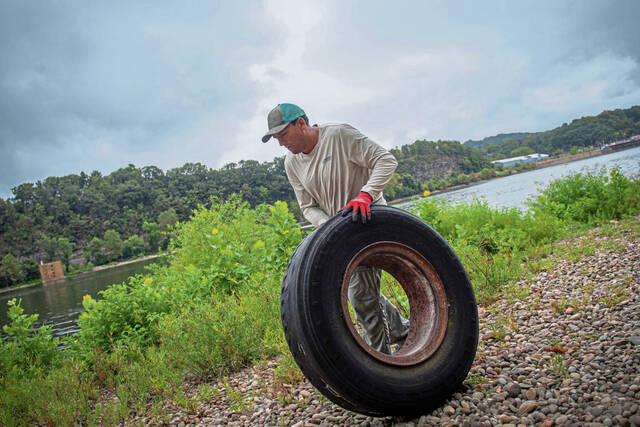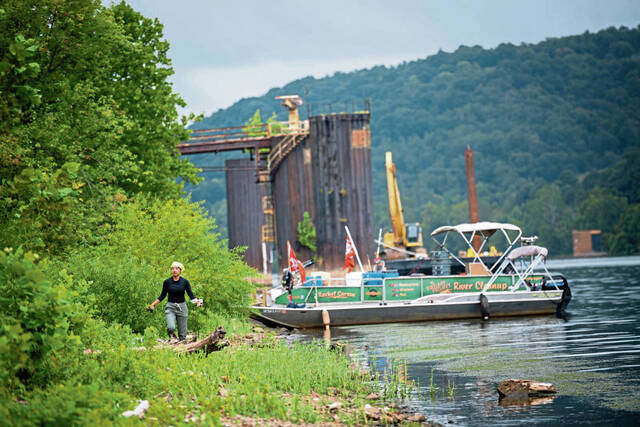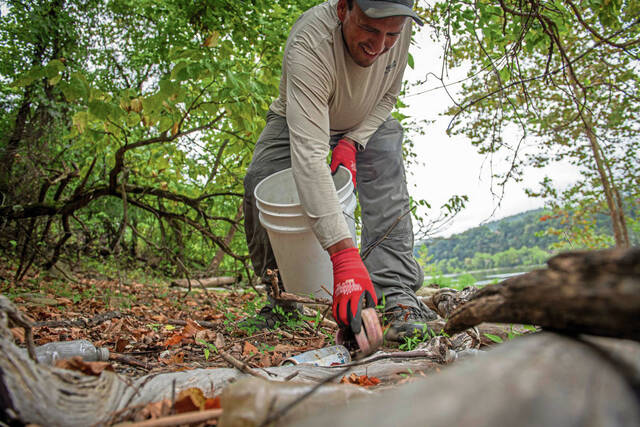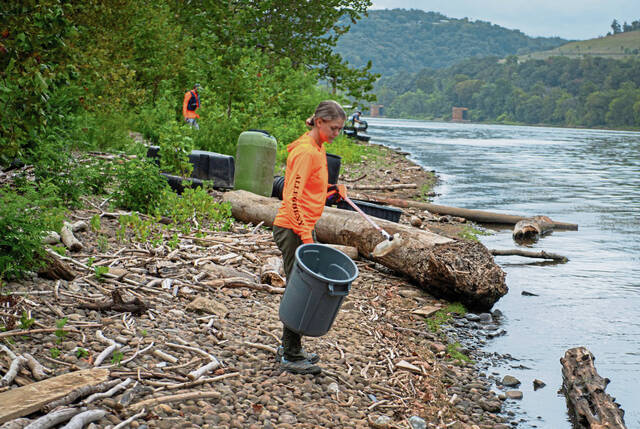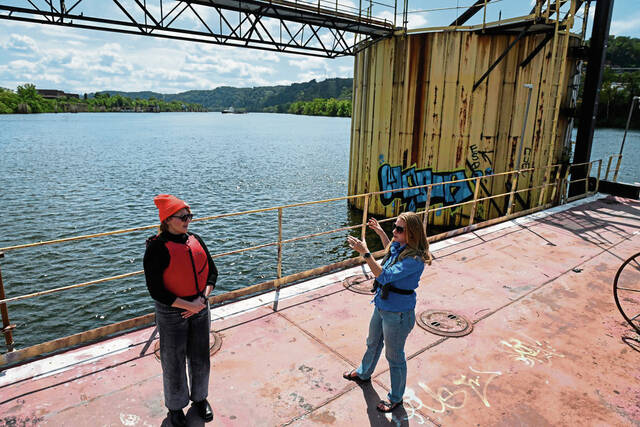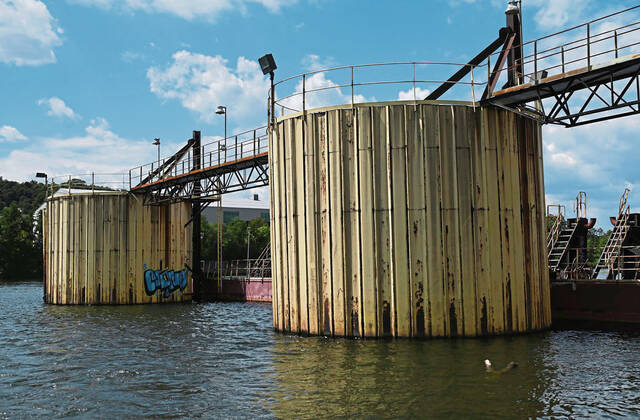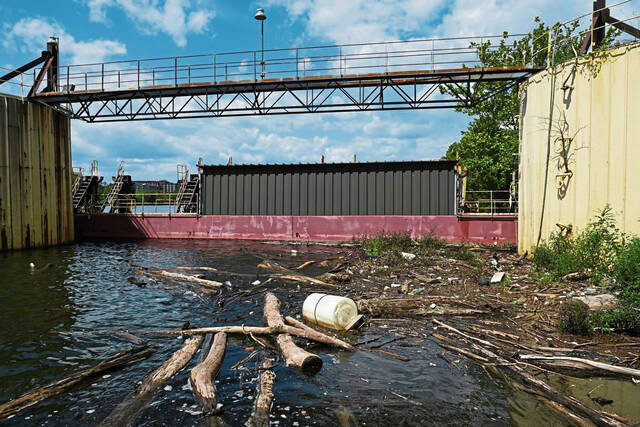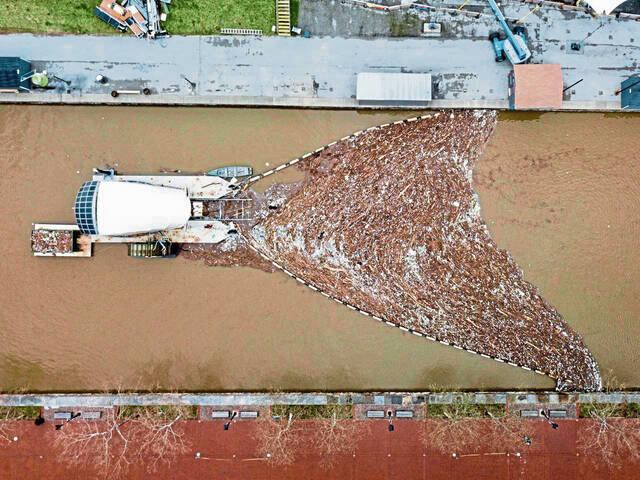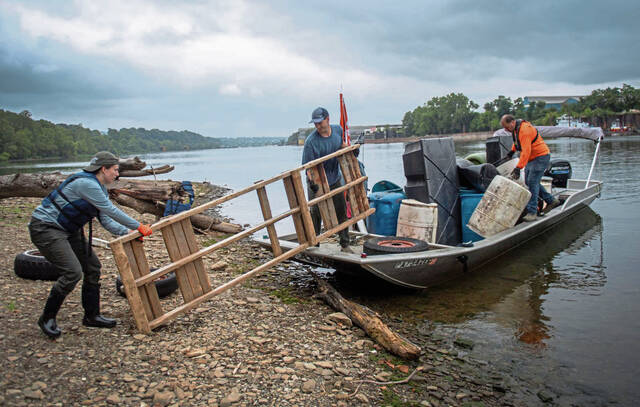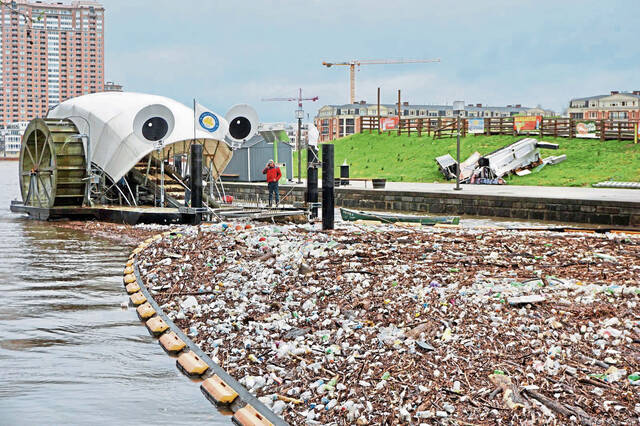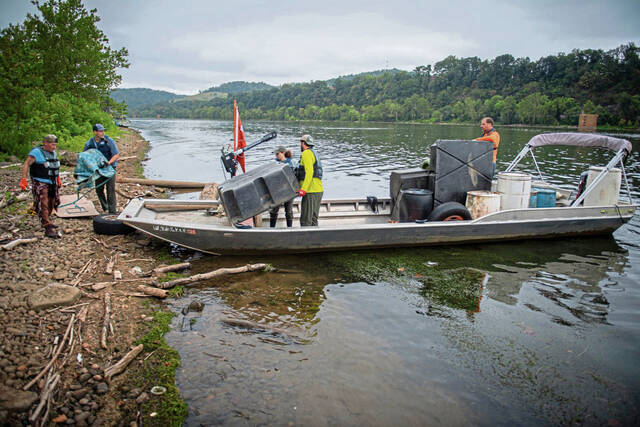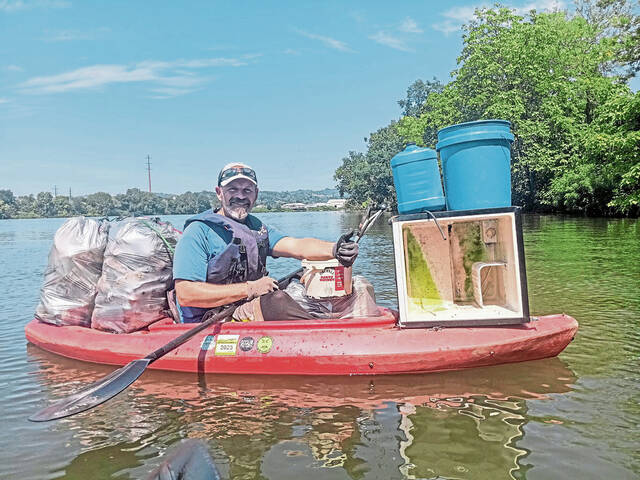'Trash wheel' could soon be installed to remove litter from Pittsburgh river
Stewards of Western Pennsylvania waterways are hoping a machine being used to prevent litter from polluting the Baltimore harbor could help keep the Steel City’s rivers clean.
Two nonprofit organizations, Allegheny CleanWays and Three Rivers Waterkeeper, are working on bringing a “trash wheel” to the Monongahela River near Hazelwood.
Powered by solar panels and the river itself, the wheel would run 24 hours a day to remove trash, taking it from the water, up a conveyor belt and into a dumpster.
A feasibility study has been completed, and the organizations are approaching foundations in pursuit of the roughly $1 million needed to get the device in the water, Allegheny CleanWays Executive Director Caily Grube said.
Allegheny CleanWays was formed in 2000 to fight illegal dumping and littering. Three Rivers Waterkeeper was founded in 2009 to improve and protect the water quality of the three rivers and their watersheds.
The site on the Mon was chosen because mooring cells in the river — structures left over from industry used to anchor barges — will provide the most expensive part of the infrastructure needed for the wheel, she said.
It would be a game-changer, Grube said, for Allegheny CleanWays, whose staff and volunteers this year pulled more than 36,000 pounds of garbage out of the Allegheny, Monongahela and Ohio rivers — by hand.
“This device would double the amount of trash that we pull out in a year,” Grube said. “To move into a device that’s stationary and removing trash more efficiently using the river itself, there are huge efficiencies that come from that.”
The biggest win, she said, could come from public perception and awareness.
“When it comes to reducing littering behavior, the first thing that we need is the infrastructure for people to appropriately dispose of things in their community,” Grube said.
Removing litter, raising awareness
That has been the case in Baltimore, where the trash wheel was first used and has become something of a local celebrity — complete with googly eyes and a name: “Mr. Trash Wheel.”
The Waterfront Partnership of Baltimore bought its wheel from Maryland-based Clearwater Mills, which invented it. The Waterfront Partnership liked it so much that the group bought three more, giving them their own names and personalities and creating the Mr. Trash Wheel family, said Adam Lindquist, vice president of the partnership.
“It’s been a game-changer for how much trash ends up in the Baltimore harbor,” he said.
But collecting trash wasn’t all officials wanted to do.
“The reason we personified it is that we wanted to not just collect trash. We wanted to affect human behavior,” Lindquist said. “Mr. Trash Wheel has done a ton to raise awareness of the impact littering has on the Baltimore harbor.”
That awareness also has helped pass laws, including a ban on foam takeout containers and plastic bags.
Since the container ban took effect in October 2020, Lindquist said, there has been an 80% drop in containers in the waterways and a similar drop in plastic bags.
Most of the trash collected now is plastic bottles, Lindquist said. They have spent the past year working on a bottle deposit law for Maryland, which stalled in the state’s 2025 legislative session.
Seeing the impact of pollution on Baltimore’s harbor was what motivated John Kellett to invent the trash wheel. He founded Clearwater Mills in 2007.
Kellett was an educator on boats that did school field trips focusing on the ecology of the harbor and Chesapeake Bay. He also was director of the Baltimore Maritime Museum, a collection of historic ships and a lighthouse in the Inner Harbor.
“Baltimore has a beautiful harbor, but particularly after a rainstorm, it would often be choked with floating trash and debris. It was bad enough that I would often overhear visitors commenting about how awful it looked,” Kellett said. “It was clear that the bulk of the trash was coming from stormwater runoff from land sources. Seeing the problem on a daily basis kept me thinking about an effective approach for addressing it.”
Kellett said they have used waterwheels that are 10 to 14 feet in diameter and 2 to 3 feet wide. The large wheels, made of galvanized steel, weigh almost 3,000 pounds. A wheel of 14 to 16 feet in diameter would likely be used for the Mon project, he said.
Kellett has been to the Monongahela River site a few times, most recently in February, to meet and consult with the team working to bring a trash wheel to Pittsburgh.
“I think it’s a good plan they’ve come up with. If somebody had said they were putting a regular trash wheel on the Monongahela, it would be a challenging undertaking. Since there are already those mooring cells in place, I think that it lends itself very well to this adaptive reuse,” he said.
“It will make a big dent. Trash favors that side anyway. It won’t stop everything headed downstream, but stopping 60% is a lot better than stopping 0%.”
Who’s responsible?
The responsibility for tackling litter most often falls to community groups and nonprofits, said Faran Savitz, a zero-waste advocate with Penn Environment in Philadelphia.
“Litter and dumping is a huge problem that’s difficult for any single agency with the current levels of funding to take on,” he said. “When it comes down to it, cleaning up falls to just engaged and concerned citizens trying to do their part for the environment.”
This past weekend, 20-plus volunteers removed about 200 tires from 4 miles of the Youghiogheny River in a cleanup organized by the Mountain Watershed Association.
“The majority of the garbage we see is tires,” said Eric Harder, the association’s Youghiogheny riverkeeper. “That’s what we’ve come to really focus on because of their aesthetic presence in the river and how much they stick out.”
But with 20 people coming out twice a year, around Memorial Day and Labor Day, Harder said it feels almost like a losing battle.
“If we were to have more capacity and more canoes and more people out there with their own motorboats, we feel that’s how we could make a very large impact,” he said. “We just don’t have the resources to be able to get that many people in the river.”
The irony of the Kiski River is that, as the river is getting cleaner, people are making it dirtier.
“Since the river is clean, more people are using it and more people are leaving trash,” said Ken Kaminski, president of the Roaring Run Watershed Association, which organizes cleanups on the river between Avonmore and Leechburg with volunteers once or twice a year.
With more people getting outdoors and fishing in the river, they’re leaving behind bottles, cans, bags and food wrappers, thinking that just one item doesn’t matter much, he said.
“You get a bunch of that, and it adds up to an awful lot,” he said. “One bottle or one can times a thousand leads to 1,000 bottles and 1,000 cans.”
A three-day Allegheny CleanWays effort along the Ohio River in late August across from Neville Island, between the Kilbuck boat launch and the Emsworth dam, collected 23 tires, 33 55-gallon plastic barrels and about 6,750 pounds of trash, said Ben Halliburton, a water program coordinator with Allegheny CleanWays.
It was one of the river cleanups the organization leads between May and October.
“Things are getting better and better by the year,” Halliburton said. “There’s been a concerted effort in the last 20 years to get things cleaned up.”
Mike Saylor, 35, of Hampton enjoys kayaking on the rivers but remembers when they were polluted and people didn’t spend time on them. He came to all three days of the cleanup. Styrofoam was what he saw a lot of.
“No matter how small it is, it doesn’t deteriorate,” he said. “It doesn’t go away. It gets smaller and harder to capture.”
Saylor said he felt like he was making a difference.
“You always know there’s more, but at least you can see you’ve made some progress in the fight,” he said.
One man’s battle
Over the past three or so years, Tom Ross says he has removed 19,000 plastic bottles from the Ohio River while kayaking between the West End and McKees Rocks bridges.
That’s not all the garbage he has removed from the river, just what he has been counting.
“I can still fill up my kayak every single day. It’s just a nonstop flow of litter,” said Ross, 51, who lives in Ross. “It’s really just nonstop.”
Ross tries to get out on the Ohio River three days a week.
“I know the work I’m doing still has value, and I want to try to use the work to inspire others to get involved,” he said. “I do feel like we are making progress. More people are aware of our litter and trash problems in the river.”
Most, if not all, of the state’s waterways have a problem with waste, some of which cannot be seen, Savitz said. Penn Environment has tested more than 100 rivers, lakes and streams for microplastics and found the waste in all of them.
“Stopping pollution is more efficient than trying to clean up what’s out there already,” he said.
Ross agrees.
“Until we can get people to stop littering at the rates they’re littering and polluting, this is not going to stop,” he said. “We’re not going to clean our way out of this.
“We have to change people’s thoughts and habits or this is never going to end.”
Brian C. Rittmeyer, a Pittsburgh native and graduate of Penn State University's Schreyer Honors College, has been with the Trib since December 2000. He can be reached at brittmeyer@triblive.com.
Remove the ads from your TribLIVE reading experience but still support the journalists who create the content with TribLIVE Ad-Free.

